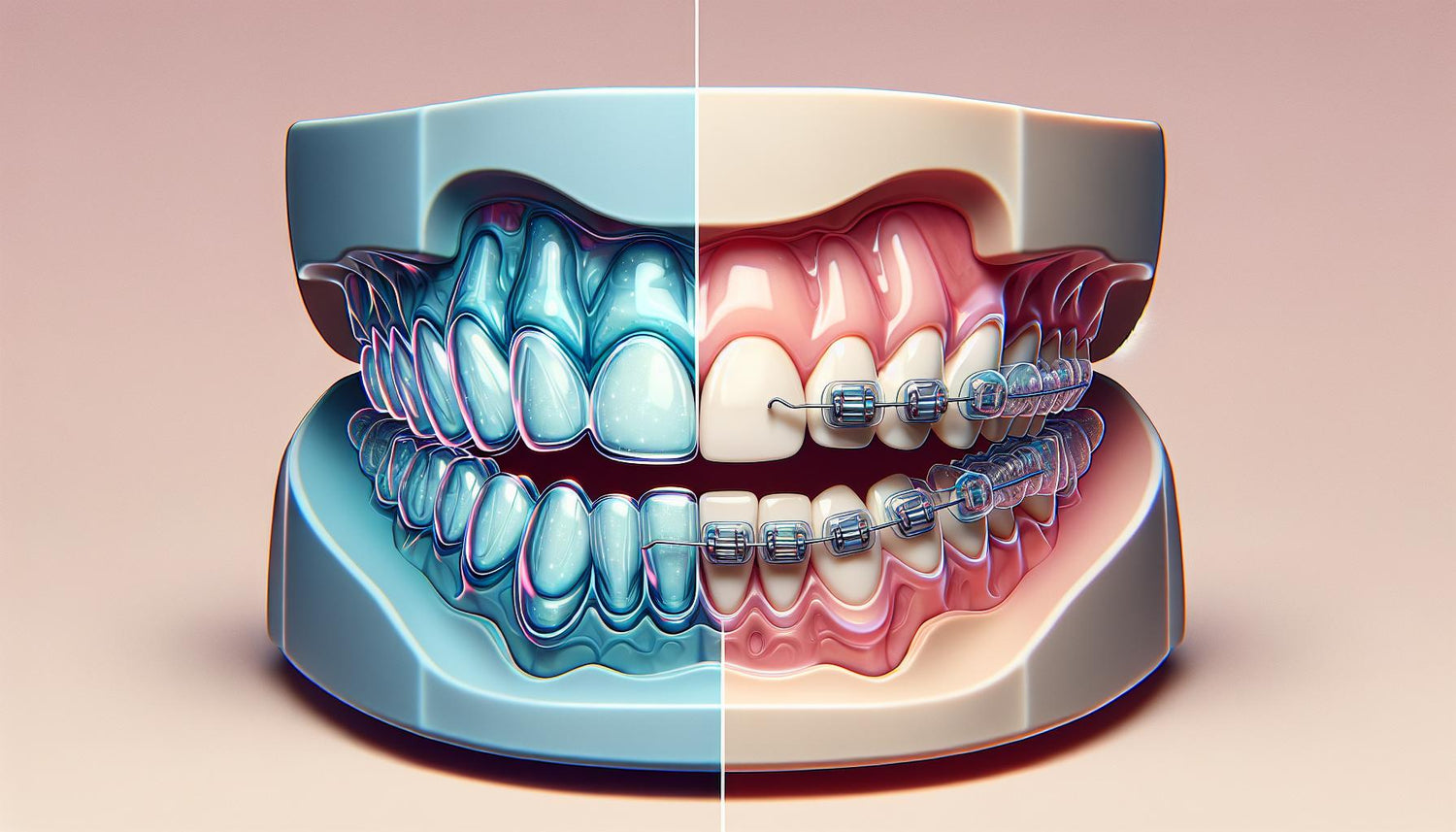When considering orthodontic options, many patients wonder about the differences between Invisalign and traditional retainers. The question, "are Invisalign retainers" simply the same as typical retention devices? In this comprehensive guide, we’ll dive deep into what sets Invisalign from standard retainers, and we’ll answer common queries such as "are Invisalign the same as retainers?" and "how do Invisalign aligners work?" Whether you’re exploring options for straightening your teeth or figuring out post-treatment care, this article has you covered.
Table of Contents
Understanding Invisalign
Invisalign is a modern orthodontic treatment that uses a series of clear, removable aligners to gradually shift teeth into the desired position. Unlike traditional braces that use metal brackets and wires, Invisalign offers a discreet, flexible solution.
Invisalign treatment involves several key features:
- Custom-made aligners: Designed specifically for your teeth to ensure a precise fit.
- Gradual movement: Each set of aligners is worn for a prescribed period, gently moving your teeth.
- Aesthetic appeal: Clear plastic material means fewer noticeable appliances compared to traditional metal braces.
- Digital planning: A 3D model is created to track progress and predict treatment outcomes.
The entire process is customized by dental professionals who determine the most effective treatment plan based on your unique orthodontic needs.
Understanding Retainers
After completing the active phase of teeth straightening through braces or Invisalign, patients are usually given retainers. Retainers are orthodontic devices worn to maintain the new position of teeth after orthodontic treatment. They are often worn for varying periods depending on the patient's case and the advice of their orthodontist.
Types of Retainers
- Fixed retainers: These are bonded to the backside of the teeth to provide continuous support.
- Removable retainers: Made of either plastic, wire, or a combination of materials, these allow for easier cleaning and flexibility.
Retainers are essential in preventing the teeth from shifting back to their original positions after the active treatment phase.
Key Differences Between Invisalign and Retainers
Primary Function
Invisalign Aligners:
Invisalign aligners are designed for active treatment. They gradually reposition your teeth over time. The treatment plan usually involves several aligners that are replaced every few weeks to continue progressing your alignment corrections.
Retainers:
Retainers are primarily used for stabilization and maintenance after active orthodontic treatment. Their aim is to keep teeth in their new, corrected positions.
Treatment Duration
Invisalign:
Treatment with Invisalign aligners can last from several months to a few years, depending on the complexity of the alignment issues.
Retainers:
Retainers can be required for shorter periods initially and then for long-term or sometimes lifetime maintenance, albeit typically worn less frequently once the teeth have settled.
Material and Design
Invisalign Aligners:
These are made of a sturdy, medical-grade clear plastic that is custom-molded to fit your teeth precisely during the active phase. The design allows for a snug fit while still being removable for eating and cleaning.
Retainers:
Removable retainers might combine a plastic base with wires to maintain the teeth's positions, while fixed retainers are usually bonded directly to the teeth. The materials and design vary depending on the type of retainer and the individual needs of the patient.
Visibility and Aesthetics
Invisalign Aligners:
One of the biggest advantages of Invisalign is its nearly invisible appearance. The aligners are transparent, making them a popular option for adults and teens who are conscious about their appearance during treatment.
Retainers:
While many retainers are also clear, some combine plastic and metal wires that can be more noticeable. However, once treatment is complete, the retention phase is often considered less critical from an aesthetic perspective compared to active alignment.
Cost Considerations
Invisalign:
Because Invisalign involves ongoing changes and digital planning paired with multiple pairs of aligners, the treatment cost can be higher compared to traditional braces or retainers.
Retainers:
Retainers generally cost less than full orthodontic treatment with Invisalign. However, proper care and possible replacements over the years should be considered in the overall expense.
How Do Invisalign Aligners Work?
-
Initial Consultation and Digital Scan:
The process begins with a consultation during which your dental professional takes detailed images or scans of your teeth. This step helps create a 3D model that outlines your treatment plan.
-
Customized Treatment Plan:
Using the 3D model, your orthodontist maps out each stage of tooth movement. This digital treatment plan shows you a preview of your smile transformation and helps customize the aligners to your specific needs.
-
Series of Aligners:
Instead of one continuous appliance, you'll receive a series of clear aligners. Each set is worn for around one to two weeks before progressing to the next set in the series. These aligners exert controlled pressure on your teeth to encourage gradual movement.
-
Periodic Check-ups:
Periodic visits to your orthodontist ensure that your teeth are moving as planned. Adjustments can be made if necessary, ensuring optimal progression.
-
Completion and Transition:
Once your treatment is complete and the desired alignment is achieved, you might transition to using retainers to maintain your smile permanently.
By understanding how Invisalign aligners work, you can appreciate that the process is not only customized but also involves multiple steps where your dental professional actively monitors and modifies your treatment as needed.
How Do Invisalign Trays Work?
-
Form and Fit:
Each tray is created based on the digital scan of your teeth. The precise fit ensures that every tooth is engaged correctly, guaranteeing uniform movement over time.
-
Gradual Movement:
Similar to aligners, the trays gently push your teeth in small increments. With each successive tray, your smile is incrementally adjusted closer to the ideal alignment.
-
Consistency is Key:
For the trays to work effectively, it's crucial to adhere to the recommended wear schedule—typically around 20 to 22 hours a day. This consistency ensures optimal results and prevents the progress from stalling.
-
Ease of Use:
One of the notable benefits of Invisalign trays is their removability. This allows for convenient eating, drinking, and cleaning. However, it is important to follow your orthodontist’s guidelines about when to remove them during your daily routine.
-
Visualizing Progress:
With the digital treatment plan synchronized to your trays, you can monitor how your teeth are shifting. This feature offers both motivation and reassurance as you see small, consistent improvements.
In essence, Invisalign trays are a crucial component of the Invisalign system that work in harmony to create the precise, controlled environments necessary for effective teeth movement.
How Do Invisalign Retainers Work?
-
Stabilization of Edges:
After significant teeth movement, it is essential to secure the results. Invisalign retainers are custom-made to fit over your new smile, holding your teeth in their corrected positions.
-
Subtle Differences:
While both Invisalign aligners and Invisalign retainers are clear, their design might slightly differ. Retainers are generally thinner and are designed to be worn for longer periods, often at night or on an intermittent basis during the day.
-
Long-Term Usage:
The primary function of Invisalign retainers is to prevent relapse—this is the process where teeth gradually shift back toward their original alignment. By wearing these retainers consistently as prescribed, you help maintain the correction achieved during the active treatment phase.
-
Customization and Fit:
Just like the active aligners, Invisalign retainers are crafted from a 3D digital model of your teeth. This ensures that they fit precisely and comfortably, enabling easy wear throughout the retention phase.
-
Ease of Transition:
The familiarity of the Invisalign system means that transitioning to using Invisalign retainers after completing your aligner series is straightforward. Your dental professional will provide guidance on how long, and under what circumstances, you should wear these retainers.
Through proper use, Invisalign retainers can be a seamless part of your daily routine, safeguarding your investment in a beautiful, straight smile.
Usage, Maintenance, and Lifespan
Wearing Schedule
- Invisalign Aligners/Trays: To achieve maximum effectiveness, these must be worn almost constantly—typically for 20 to 22 hours per day. They should only be removed during meals and for brushing your teeth.
- Retainers: Initially, retainer wear may be full-time after active treatment until your teeth settle into their new positions. Later, usage might shift to nighttime wear or as recommended by your orthodontist.
Cleaning and Maintenance
- Gentle Cleaning: Use appropriate cleaning tools recommended by your orthodontist. Regular cleaning prevents plaque buildup and preserves clarity.
- Safe Storage: When not being worn, ensure that aligners or retainers are stored securely in their cases. This protects them from damage and environmental exposure.
- Regular Check-ups: Routine visits to your dental professional are important. They can monitor your progress, check for signs of wear, and make necessary adjustments.
Lifespan Considerations
- Invisalign Trays: Typically, each aligner is used for one to two weeks before being replaced by the next in the series. Adjustments in the series ensure that your teeth move in small, controlled increments.
- Retainers: Retainers are expected to last several years, but they may need replacement if you experience significant wear or if your teeth undergo any minor shifts.
Choosing the Right Option for You
Both Invisalign aligners and various types of retainers serve distinct purposes in the journey towards an optimal smile. When deciding which is the best option for you, consider the following:
- Treatment Goals: If your aim is active correction of misaligned teeth, then Invisalign aligners are the solution. They are designed specifically for progressive repositioning of your teeth.
- Post-Treatment Maintenance: Once the active treatment is complete, maintaining the results with retainers becomes the focus. While both Invisalign and traditional retainers may look similar, their purposes differ significantly.
- Lifestyle Considerations: Invisalign aligners are popular for their aesthetic appeal and removable design, making them convenient for professionals or anyone conscious about their appearance. On the other hand, retainers are generally more about stabilization rather than ongoing transformation.
- Cost and Commitment: Invisalign may involve a more significant investment upfront due to the number of trays and the digital customization process. Retainers, while generally less costly, require adherence to a long-term schedule to preserve your smile.
Understanding these considerations will help you have an informed discussion with your orthodontist about your needs. Ask your provider questions like, "are Invisalign retainers a good long-term solution for my situation?" or "are Invisalign the same as retainers for someone who has completed active orthodontic treatment?" This dialogue is central to tailoring a treatment plan that best aligns with your dental goals.
Conclusion
Understanding the distinctions between Invisalign (with its aligners/trays) and retainers is vital for anyone considering orthodontic treatment. While both are critical components in the journey toward a confident smile, their functions are distinct—active correction versus long-term retention. Whether you are asking, "how do Invisalign aligners work?" or "how do Invisalign retainer trays work?" clarity in these differences can help you gain a better grasp of your orthodontic treatment plan.
If you’re contemplating starting treatment or just want a refresher on retaining your beautiful smile, consult your dental professional. They can guide you on whether Invisalign or traditional orthodontic systems suit your needs best, and help maintain your progress in the most effective manner possible.
Choosing the right orthodontic treatment is not just about aesthetics or cost—it’s about achieving and preserving a smile that feels natural and confident. With the right information and professional advice, you can navigate the differences between active Invisalign treatment and retainer use, ensuring that your journey toward a beautiful smile is smooth and successful.
Remember, every smile is unique, and the best treatment plan is one that caters to your individual needs. Embrace the process, follow the guidelines, and look forward to the remarkable results that come with a well-planned orthodontic journey. Enjoy the peace of mind that comes with understanding "how do Invisalign retainers work" and "how do Invisalign trays work," and set off on your path to a stunning, long-lasting smile.


